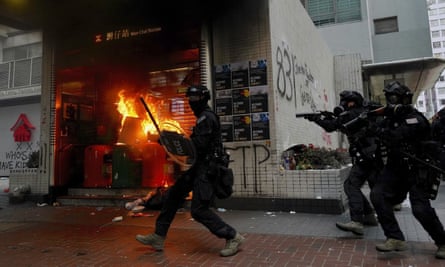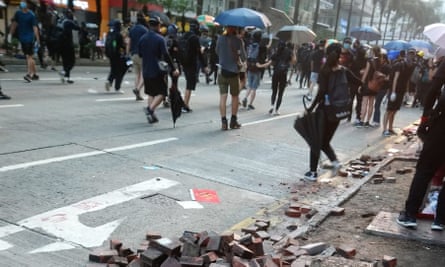Some of Hong Kong’s busiest shopping districts have descended into chaos after police used teargas, rubber bullets, pepper spray and water cannon against protesters.
Activists hurled bricks and petrol bombs back at the police and started street fires on Sunday as demonstrations entered their 17th week in the city’s most serious political crisis in decades.
The protest, which was not sanctioned, was scheduled to start at 3pm local time (0800 BST) in the Causeway Bay shopping district, but dozens of riot police began guarding the area hours before. They stopped and searched a number of young people dressed in black.
The crowds chanted “Black cop! Black cop!” as they saw riot police. At about 2.20pm, before the march was due to start, officers fired several rounds of teargas at crowds congregating in front of the Sogo department store. Police had earlier subdued several protesters and angered the crowds.

Protesters targeted by teargas ran in panic, but many began marching along the scheduled route towards Admiralty, a business district where the government headquarters is located.
Some protesters regrouped outside the headquarters and threw bricks and petrol bombs at officers. Riot police later fired rounds of teargas at protesters outside an upmarket shopping centre in Admiralty and near the government headquarters. They also used water cannon to spray protesters with water mixed with blue dye and stinging chemicals.
Dozens of protesters were arrested after being chased by police, with many tackled to the ground and some left bleeding heavily. A number of protesters were also made to line up against the wall on the main road.
As activists retreated from Admiralty, some made makeshift barricades and set them ablaze. Street fires were also started in the Wan Chai district in an attempt to stop the police from approaching.

Some protesters later threw petrol bombs at police who had entered Wan Chai metro station, the public broadcaster RTHK reported. It also said undercover police wearing black clothing typical of protesters were seen retreating into the station with the help of uniformed officers. Police have admitted sending officers disguised as protesters to carry out operations during demonstrations.
A young man in full protective gear said: “I don’t want violence either, but the authorities are using hardline measures against us, so I’m fighting against them with my life.”
After dark, more clashes took place and police again fired multiple rounds of teargas. Large groups of riot police encroached on a diminishing group of protesters in Causeway Bay after a water cannon put out fires.
Dozens of protesters marched towards a large group of riot police, prompting officers to deploy teargas.
Later in the evening, police left the scene in vans as protesters jeered at them. Some activists threw sticks and bricks and a police vehicle stopped to fire two rounds of teargas. More teargas was fired late at night in Wan Chai, local media reported.

Earlier in the day, helicopters had hovered above the protest areas as demonstrators opened their umbrellas, saying they feared an unknown liquid was being sprayed at them.
A number of middle-aged people said they were there to protect young protesters.
“These kids feel hopeless and they’re willing to give their lives even – they need us to protect them,” said Vanita Chan, 55, who said she had bought supplies such as saline, goggles and raincoats to hand out to protesters.
A woman identified only as Mrs Lau, 56, said: “If we don’t speak up now there won’t be another opportunity, the Hong Kong and Chinese governments are cracking down on us already.
Quick GuideWhat are the Hong Kong protests about?
Show
Why are people protesting?
The protests were triggered by a controversial bill that would have allowed extraditions to mainland China, where the Communist party controls the courts, but have since evolved into a broader pro-democracy movement.
Public anger – fuelled by the aggressive tactics used by the police against demonstrators – has collided with years of frustration over worsening inequality and the cost of living in one of the world's most expensive, densely populated cities.
The protest movement was given fresh impetus on 21 July when gangs of men attacked protesters and commuters at a mass transit station – while authorities seemingly did little to intervene.
Underlying the movement is a push for full democracy in the city, whose leader is chosen by a committee dominated by a pro-Beijing establishment rather than by direct elections.
Protesters have vowed to keep their movement going until their core demands are met, such as the resignation of the city’s leader, Carrie Lam, an independent inquiry into police tactics, an amnesty for those arrested and a permanent withdrawal of the bill.
Lam announced on 4 September that she was withdrawing the bill.
Why were people so angry about the extradition bill?
Beijing’s influence over Hong Kong has grown in recent years, as activists have been jailed and pro-democracy lawmakers disqualified from running or holding office. Independent booksellers have disappeared from the city, before reappearing in mainland China facing charges.
Under the terms of the agreement by which the former British colony was returned to Chinese control in 1997, the semi-autonomous region was meant to maintain a “high degree of autonomy” through an independent judiciary, a free press and an open market economy, a framework known as “one country, two systems”.
The extradition bill was seen as an attempt to undermine this and to give Beijing the ability to try pro-democracy activists under the judicial system of the mainland.
How have the authorities responded?
Beijing has issued increasingly shrill condemnations but has left it to the city's semi-autonomous government to deal with the situation. Meanwhile police have violently clashed directly with protesters, repeatedly firing teargas and rubber bullets.
Beijing has ramped up its accusations that foreign countries are “fanning the fire” of unrest in the city. China’s top diplomat Yang Jiechi has ordered the US to “immediately stop interfering in Hong Kong affairs in any form”.
Lily Kuo and Guardian reporter in Hong Kong
“We don’t want our next generation to lose our freedoms. We don’t accept one country, one system.” This was a reference to China’s agreement to give Hong Kong semi-autonomy – “one country, two systems” – after taking control of the city back from the UK in 1997.
Many shops in the area closed. Protesters spray-painted a closed Starbucks cafe in Wan Chai with messages calling on people to boycott it. The company that runs the cafe chain in Hong Kong is seen by protesters as being pro-Beijing.
Young protesters wearing black were digging up paving stones at a crossroads in Wan Chai while others smashed glass panels at a metro exit of Wan Chai station, which has been closed. The outer walls of the exit were also spray-painted with anti-police messages and “Free HK”, “Reclaim HK, revolution of our era”.

Protesters are angry that in past weeks, the metro company has allowed police to go into the station to beat protesters and close it during protests, but has provided carriages to transport riot police officers.
Hong Kong has been gripped by a wave of protests since June, sparked by a controversial extradition bill, but the movement has become increasingly violent as animosity has grown between protesters and police.
Hong Kong is bracing for consecutive days of protests and clashes, culminating with anti-government demonstrations on Tuesday to coincide with China’s National Day, marking 70 years since the founding of the People’s Republic of China.